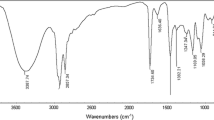Abstract
A general colorimetric method has been developed to analyze either anionic or cationic surfactants in fresh water. An appropriate dye will react with ionic surfactant to form a chloroform-soluble, colored complex in the presence of chloroform. The color intensity of the vigorously rocked and subsequently settled chloroform layer is proportional to the concentration of the “dye-ionic surfactant complex”, and can then be measured by making spectrophotometric readings of the chloroform solution at the optimum wavelength of the instrument used. When cationic surfactants are to be analyzed, methyl orange shall be used as a dye; when anionic surfactants are to be analyzed, azure A or methylene blue shall be used as a dye. Other chemical reagents, apparatus and spectrophotometers, however, can be nearly identical for either cationic surfactant or anionic surfactant measurement. This new analytical method is stoichiometric, and can be easily performed by a laboratory technician within a very short period of time.
Similar content being viewed by others
References
Anonymous: American Public Health Association, Standard Methods for the Examination of Water and Wastewater, 13th Edition, pp. 339–346 (1971a).
Anonymous: A.S.T.M. Standards, Part 23, Water, Atmospheric Analysis, American Society for Testing and Materials, Philadelphia, Pa., p. 619 (1972a).
Anonymous: Permits for Work and Structures in, and for Discharges or Deposits into Navigable Watrs, Department of the Army, Corps of Engineers (1971b).
Anonymous: Product Data Bulletin, Bulletin No. 69-8, Armak Chemicals Division, Chicago, Illinois (1972b).
Anonymous: Synthetic Organic Chemicals, U.S. Production and Sales. TC Publication 412,U.S. Tariff Commission (1969).
Anonymous:U.S. Environmental Protection Agency, Methods for Chemical Analysis of Water and Wastes, U.S. Government Printing Office, Washington, D.C., 20402, pp. 131–133 (1971c).
Anonymous:U.S. Environmental Protection Agency, National Pollutant Discharge Elimination System: Application for Permit to Discharge Wastewater, EPA Form 7550-22A, OMB No. 158-R0100 (1973).
Ehlers, V. M., and E. W. Steel: Municipal and Rural Sanitation, Sixth Edition, McGraw Hill, New York, pp. 272–277 (1965).
Kroner, R. C.: Personal Communication. (from Chief of Physical & Chemical Methods,U.S. Environmental Protection Agency, Cincinnati, Ohio) to L. K. Wang, dated September 14 (1972).
Wang, L. K.: Evaluation of improved two-phase titration methods and a field test kit for analyzing ionic surfactants in water and wastewater. Calspan Corporation, Buffalo, New York, Technical Report No. ND-5296-M-3, 66 pp. (1973b).
Wang, L. K.: Feasibility study of treating field military wastewater by a process system including powdered carbon adsorption, polymer coagulation, and diatomite filtration. Calspan Corporation, Buffalo, New York, Technical Report No. ND-5296-M-2, 106 pp. (1973a).
Wang, L.K.: Improved colorimetric methods and field test kits for analyzing anionic surfactants in water and wastewater. Calspan Corporation, Buffalo, New York, Technical Report No. ND-5296-M-4, 54 pp. (1973c).
Wang, L.K.: Modified methylene blue method for estimating MBAS concentration. J. Amer. Water Works Assoc.67, 19 (1975a).
Wang, L. K. and G. G. Peery, III: A potential organic disinfectant for water purification. J. New England Water Works Assoc.89, 250 (1975).
Wang, L. K., and S. L. Pek: Cationic surface-active agent as bactericide. Ind. Eng. Chem.14, 308 (1975).
Wang, L. K., W. W. Shuster, and P.J. Panzardi: Evaluation of two methylene blue methods for analyzing MBAS concentrations in aqueous solution. J. Amer. Water Works. Assoc.67, 182 (1975b).
Wang, L. K., J. Y. Yang, and M. H. Wang: A proposed method for the analysis of anionic surfactants. J. Amer. Water Words Assoc.67, 6 (1975).
Wang, M H., M. L. Granstrom, T. E. Wilson, and L. K. Wang: Removal of lignin from water by precipitate flotation. Journal of the Environmental Engineering Division, Proceedings of the American Society of Civil Engineers100 (EE 3), 629 (1974a).
Wang, M. H., M. L. Granstrom, T. E. Wilson, and L. K. Wang: Lignin separation by continuous ion flotation: Investigation of physical operational parameters. Water Resources Bull.10, 283 (1974b).
Author information
Authors and Affiliations
Rights and permissions
About this article
Cite this article
Wang, L.K., Langley, D.F. Identification and determination of ionic surface active agents. Arch. Environ. Contam. Toxicol. 5, 447–456 (1977). https://doi.org/10.1007/BF02220924
Issue Date:
DOI: https://doi.org/10.1007/BF02220924




